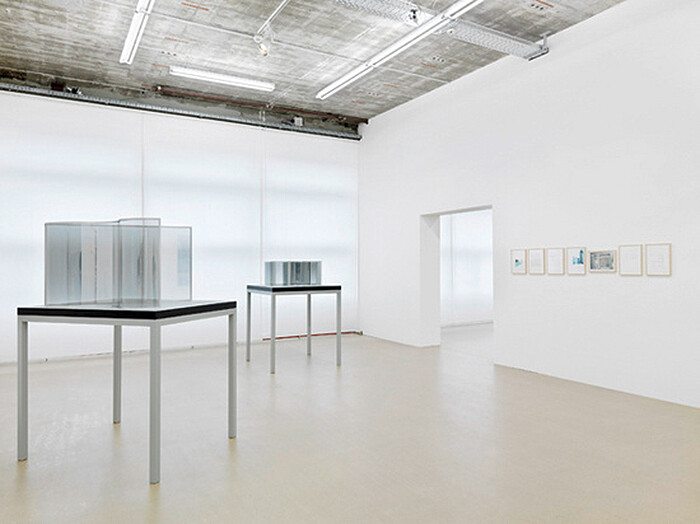It’s an imperfect exhibition, neither focusing on one aspect of Dan Graham’s work, nor conveying its breadth: nonetheless, since his MoCA LA retrospective in 2009 (and before that to boot), it has hardly seemed necessary to state his importance in the development of conceptual art, or how his multifaceted practice swoops merrily from high to low registers, embedded in social observation and engagement with his audience. With this in mind, the exhibition’s saving grace is that Graham is not afraid to prick the bubble of his own hype.
The exhibition features three models for glass and aluminium pavilions. They’re each 70 cm tall and presented here almost at (adult) eye level on table-like pedestals. It’s a beguiling game of smoke and mirrors, in which we oversized observers are reflected like giants while taking in Graham’s optical trickery created by a variety of glass and metal treatments. From one side, Sine Curve / Straight Line Two-Way Mirror Pavilion (2011), projects an amorphous curved doubling of its form; when viewed from the other direction, it disappears into itself. But the po-faced reverence with which these structures are received does them no favors, putting them in danger of being seen merely as monumental, formal investigations.
Perforated steel crops up often enough in the pavilions and in the Lisa Bruce Boutique Design proposal from 1997, made in collaboration with Apolonija Sustersic. This concept on paper fulfils both titular remits—being child-like and boutique—and from the outside, the mirrored glass would allow passersby to see themselves in the clothes displayed in the window, like paper dress-up dolls; while the perforated metal proposed for changing rooms inside weighs in like a childish teenage prank, being a solid material that nonetheless reveals the customer inside.
Significant space is given to Children’s Pavilion (1989), an unrealized project designed with Jeff Wall for a site in France that has much in common with a James Turrell Skyspace: it’s a cave built into an artificial hill with an aperture on top as well as the possibility of looking down into a mirrored lens from above. The spirit of Roman Signer is here as well, as Eleven Sugar Cubes, a work first published in Art in America in 1970, has been reissued in 2012 as a 24-part photograph series that documents how sugar soaked in detergent then dropped into an already polluted sea at Jersey City, New York, fizzed and dissolved. It’s an off-the-cuff commentary on the then-topical land art and the drug-infused utopia of the 60s and 70s that, as Graham has stated baldly, “was no utopia.”
The one full-size structure, Pavilion for Showing Rock Videos/Films (Design I) (2012), is a poor example of what Graham can achieve architecturally. A curved glass wall shelters a zigzag one, around which six monitors are positioned on the floor, screening a selection of the artist’s favorite rock n’ roll films. These form a captivating group of international documents, from Rodney Graham and his band’s charmingly straight Tribute to Dan Graham, to Manchester’s The Fall’s Perverted by Language (1983), and the home-grown PUNK COCKTAIL: Zurich Scene 1976-80 (2006), compiled by René Uhlmann, that proves Graham’s commitment, as if proof were needed, to punk and avant-rock music but does little to sell the pavilion. The equipment makes a tangle of stuff that distracts from the form, while hard benches don’t encourage the suggested lounging and headphones isolate each viewer.
Luckily there is one more element, easily overlooked, at the exhibition entrance. Pavilion Documentation (2008), is a two-minute film of two Swiss installations, one at the Novartis Campus in Basel and the other at a private home. While adults gleefully play around the former, the only child to be seen in the show, a boy of about eight, walks world-wearily through the latter. Ultimately these works are not for children but for Peter Pan figures unwilling to relinquish childish pursuits. If Dan Graham is to be elevated to the pantheon of great living artists, it’s just as well that he himself is willing to lower the tone so he can continue to mine a seam of juvenile rebelliousness.






